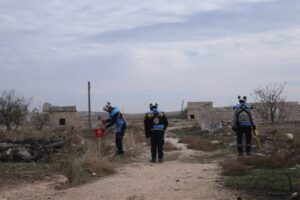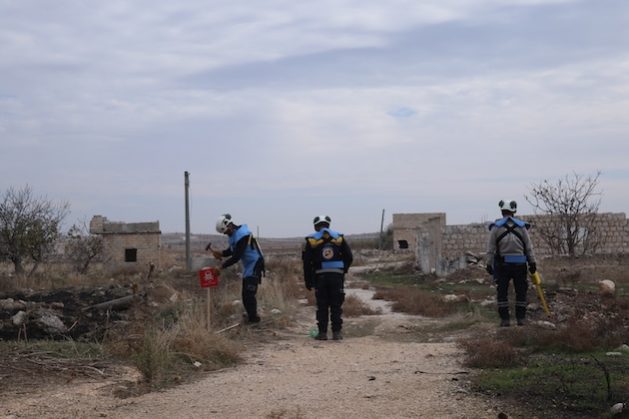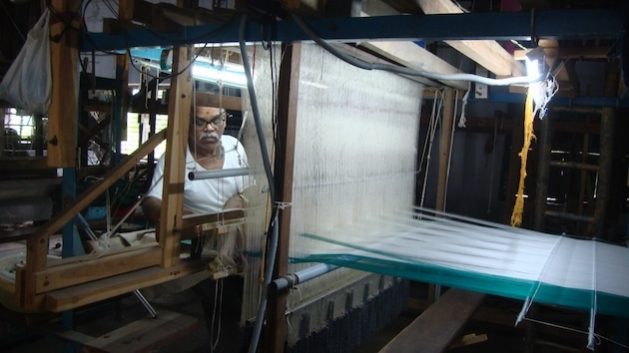
Aid, Civil Society, Democracy, Development & Aid, Editors’ Choice, Education, Europe, Featured, Headlines, Health, Human Rights, Humanitarian Emergencies, Sustainable Development Goals, TerraViva United Nations

Crowley Logistics in Miami, Florida, was one of three USAID shipping and logistics facilities in the nation. It could, in times of emergency humanitarian relief aid, respond with supplies delivered to aircraft at Miami International Airport within two hours. Credit: USDAID/Lance Cheung
– As the full effects of the US decision to freeze foreign aid funding begin to be felt across the world, organizations in Eastern Europe and Central Asia (EECA) are warning years of work in everything from delivering life-saving healthcare to defending human rights and strengthening democracy could be undone.
In many countries in the region, foreign aid is vital for the continued functioning of large parts of civil society and the activities NGOs and other groups carry out.
But since US President Donald Trump’s executive order on January 20 freezing foreign aid for 90 days and a ‘stop work order’ announced four days later, some groups have had to entirely, or partly, shut down their operations—with potentially devastating consequences.
One area that has been heavily affected is the fight against HIV/AIDS.
According to a UN report published in 2024, only half of the 2.1 million people living with HIV in the EECA region have access to treatment, and just 42% of people living with HIV have suppressed viral loads—the lowest rate in the world. In 2023, 140,000 new cases of HIV infection were registered in the region.
US funding has been central to the HIV response in EECA, including through the US President’s Emergency Plan for AIDS Relief (PEPFAR), as well as USAID.
According to UNAIDS, this support has helped fund community-based HIV prevention programmes, provision of antiretroviral therapy (ART), development of laboratory and diagnostic infrastructure, and training of health workers. It has also played a key role in prevention and harm reduction programmes among key populations.
This is critical in a region where 94 percent of new HIV cases occur among key populations and their partners.
While US aid is not the primary source of funds for HIV programmes in some countries in the region, in others it is vital.
In Ukraine, which has Europe’s second worst HIV epidemic, local groups working with key populations and people living with HIV say the aid freeze has had a dramatic impact.
The charity 100% Life provides treatment and prevention services to marginalized communities, including drug users and people with HIV, TB, and other diseases, often operating in frontline areas.
Dmytro Sherembei, head of the Coordination Council of 100% Life, told IPS that up to 25 percent of specialist staff carrying out testing, monitoring and other tasks would have to be laid off, while testing programmes and other assistance for state healthcare projects would be stopped.
“The funding suspensions stopped our whole programme, and it will cause a lot of damage,” he said.
Meanwhile, the Alliance for Public Health (APH), one of the country’s largest healthcare NGOs, said its HIV case-finding operations had been suspended after the aid freeze.
“About 35-40 percent of all HIV-positive cases in Ukraine are found, tested, and referred for treatment by APH and its partners. It will be difficult to find alternative funding,” Andriy Klepikov, Executive Director of APH, told IPS.
APH estimates the halt to testing could mean thousands of cases going undetected during the 90-day suspension of aid.
There are also concerns that treatment for more than 100,000 patients with HIV may be interrupted. Since the beginning of Russia’s full-scale invasion, the Ukrainian government has not had funds to procure antiretroviral drugs (ARVs), and PEPFAR has been procuring ARVs for all patients.
The country has ARV stocks for the next six months, “but a suspension of funding could impact the next delivery of medications planned for March,” Klepikov said.
“This funding stop threatens to turn a manageable epidemic into a deadly crisis,” warned Sherembei.
In Tajikistan, US funding has supported services including treatment and prevention among key populations, training of professionals, strengthening of local organizations, and support for community-led initiatives.
But the funding freeze is threatening to undo years of progress, local HIV activists told IPS.
Pulod Dzhamalov, Director of the Tajik NGO SPIN PLUS, said services for people living with HIV and other key populations in many places had “simply ceased to exist.”
“For many people who sought these services, it was the only place where they felt safe. And staff who worked on these projects have suddenly found themselves unemployed, without any means of livelihood or hope for the future. Significant resources were invested in building a positive image of these services, and now all of that has gone to waste. A considerable portion of the national HIV prevention programme’s budget was covered by PEPFAR funding, and this will inevitably impact the healthcare system as a whole,” he said.
Takhmina Haiderova, head of the Tajik Network of Women Living with HIV, said her organization was “facing serious challenges” and that the freeze on US funds had had a significant impact on all HIV-service NGOs in the country.
“Reduced funding results in fewer HIV prevention and treatment projects, staff reductions, and limited access to life-saving services such as testing, counseling, and treatment. In addition, it negatively affects the achievement of the Sustainable Development Goals, such as reducing the spread of HIV, improving the quality of life of people living with HIV, ensuring gender equality, and upholding human rights,” she said.
The decision to freeze funding, especially in places where the epidemic is not improving, such as EECA, risks doing irreparable harm to global efforts to fight HIV, activists say.
“[The Trump administration’s] efforts are doing irreparable harm to the global HIV response and global health more broadly. These are inefficient, wasteful and deadly policy moves,” Asia Russell, Executive Director of the Health Gap advocacy organization, told IPS.
But it is far from just efforts to fight HIV/AIDS in the region that have been affected by the pause on US aid.
In many countries, foreign funding is essential to the survival of independent media, keeping a check on autocracies and serving audiences living under repressive regimes.
Press freedom watchdogs say the aid freeze has created confusion, chaos, and uncertainty among media organizations and outlets that rely heavily, or completely, on American funds.
Exiled media reporting for audiences in countries such as Russia, Belarus, and others from outside those states are particularly vulnerable.
“This is very bad news for exiled media that relocated to democratic countries after crackdowns. Some newsrooms from Belarus have reported a complete lack of funding due to the current [US aid] freeze, which may lead to a complete cessation of these projects due to the inability to pay employees. Others have been forced to cut their staff, which is very worrying since they have so far managed to keep their audience in their country, despite being forced into exile. Their efforts made it possible to effectively counter official Belarusian and Kremlin propaganda,” Jeanne Cavelier, Head of Eastern Europe & Central Asia Desk at Reporters Without Borders (RSF), told IPS.
Meanwhile, in Ukraine, where nine out of ten outlets rely on subsidies and USAID is the primary donor, a survey after the aid freeze showed that almost 60% of media professionals surveyed believe that the suspension of US media support programmes could have ‘catastrophic consequences and lead to the closure or significant reduction in the work of many independent media outlets,’ according to RSF.
“Projects funded by American aid, such as USAID, were mostly intended to enable the media to investigate corruption and public spending. This is critical for reliable information, as well as for small media outlets reporting from the frontline,” said Cavelier.
“The freeze has already led a number of newsrooms to cut back on content, lower salaries, increase part-time working and reduce staff numbers,” she added.
Editors at local independent media outlets fear the suspension could lead to publications turning to other sources of funding, which could then look to change editorial stances, influence the independence of these media and, potentially, become tools for Russian propaganda.
There are similar fears in other parts of the region.
“The independent media here relies very much on foreign funding because otherwise they would not be economically viable in a country that is poor and in a market where some media are financed by shady Russian money,” Valeriu Pasha, Programme Manager at Moldovan think tank WatchDog.Md, told IPS.
“I think we could definitely see some deals where some media that are now struggling with funding could be bought by, or would start to be funded through, Russian sources in some way,” he added.
However, he pointed out that it was not just independent media that had been affected by the US aid freeze.
“This will have quite an effect on civil society here; plenty of organizations will feel its impact,” he said, pointing out that groups involved in everything from local election observation to healthcare, rights defense, and even working with the government on judicial reform were reliant to some extent on US aid.
“Even our organization, which has not really been affected by this so far, could well be affected in the future. We don’t know,” he added.
The freezing of US funding may also have had an unexpected, although equally pernicious, effect on civil society in the region.
The US administration’s apparent efforts to effectively shutter USAID have been welcomed by authoritarian leaders who have already been cracking down on NGOs and others they see as critical of their regimes.
In Georgia, USAID is currently investing in scores of programmes across the country with a total value of USD 373 million, according to local media. These initiatives focus on, among others, strengthening democratic institutions and increasing public resilience to disinformation.
Much US funding to the country was stopped last year in response to increasingly authoritarian behavior by the ruling regime—including legislative crackdowns on civil society.
But Prime Minister Irakli Kobakhidze earlier this month told local journalists the stop on USAID activities proved his government’s previous claims that the organization’s funds were used not for humanitarian goals but to “stage revolutions, sow disorder, and destabilize countries, including Georgia.”
Lawmakers appear to have also taken it as confirmation of the hardline approach they have already taken to civil society and the media—including a controversial law on foreign funding of NGOs introduced last year, which forced many to close—and emboldened them to tighten restrictions even further. On February 5, a media regulation law was announced that would ban foreign funding of media, as well as an even more restrictive version of the law on foreign funding for NGOs.
Reports have suggested authorities in Russia, where a swathe of laws and repressive measures have already forced the closure of many key services provided by civil society groups in areas from HIV prevention and help for marginalized groups to rights organizations, may be planning to ask US Congress to share a list of Russian citizens who received US funding with Russia’s Federal Security Service (FSB).
Groups affected by the funding freeze are looking to find alternative sources of finance. Some have called for governments, particularly in Europe, to step in and fill the gap left by the withdrawal of American money.
In a statement, a group of European disability organizations and services called on the European Union and non-governmental donors to provide emergency and long-term funding to disability organizations affected by the cuts in US funding.
They highlighted that organizations were implementing lifesaving programs in countries such as Ukraine, Moldova, Georgia and Albania and that the loss of funding will put at risk organizations and persons with disabilities in the Balkans, Eastern Europe and South Caucasus, leaving hundreds of thousands without support.
While there are hopes that US funding will, sooner or later, resume once the Trump administration finishes its review, whatever US foreign aid is resumed, it is unlikely to be disbursed in the same way as it was previously, said Pasha.
“I expect that some aid will resume in some form after the 90-day freeze, but it will reflect the priorities of the new US administration—in the future it will likely be less connected to values and more to economics,” he said.
IPS UN Bureau Report














